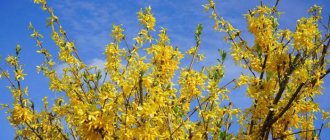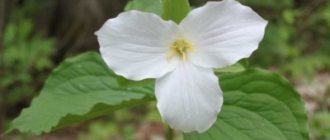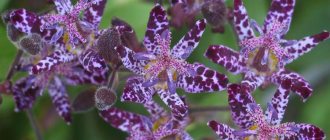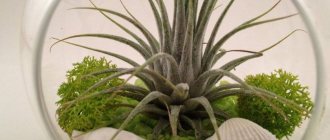Author: Natalya Category: Garden plants Published: January 19, 2019Republished: February 20, 2019Last edits: November 03, 2020
- How to plant
- Home freesia
- Armstrong's Freesia (Freesia armstrongii)
Freesia or Cape lily of the valley has not gone out of fashion for hundreds of years. Once upon a time it was hunted by court gardeners and perfumers, now by fashionable florists, brides and photographers. If you dream of growing this outrageous celebrity of the flower world yourself, be patient and arm yourself with the invaluable experience of your colleagues.
- How to grow freesia without a greenhouse?
- What color freesia grows the fastest?
- How to provide moist air to your home freesia and not destroy it?
- Is it possible to make capricious freesia bloom in the middle of winter?
Let's figure it out together!
Planting and caring for freesia
- Planting: in open ground from the second decade of May. For forcing by January - at the end of August in a pot.
- Excavation: October.
- Storage: a month after digging at a temperature of 25˚C, then before planting at 10˚C.
- Flowering: in the garden – August-September.
- Lighting: light partial shade.
- Soil: loose, well-drained, neutral or slightly acidic.
- Watering: during growth and flowering - abundant and regular, then watering is gradually reduced.
- Fertilizing: in the garden: for seedlings - with nitrogen fertilizers, then twice a month with phosphorus and potassium fertilizers.
- Reproduction: seed and vegetative (corms).
- Pests: thrips, spider mites, aphids.
- Diseases: fusarium, scab, gray, dry, penicillium, hard and sclerotial rot.
Read more about growing freesia below.
Freesia (lat. Freesia) , or freesia , is one of the most charming bulbous plants grown both in the garden and at home. Freesia is a genus of herbaceous bulbous perennials of the Iridaceae (Iridaceae) family, which includes about 20 species. The most famous is hybrid freesia, which appeared as a result of crossing several species about a century ago. The plants are native to South Africa, where they grow along wet banks and among bushes. They received their name in honor of Friedrich Friese, a German botanist and doctor.
Freesia is elegant, graceful and delicate, it exudes a pleasant aroma reminiscent of the smell of lily of the valley, and for this it is sometimes called “Cape lily of the valley”. Thanks to all these qualities, it is now at the peak of popularity among gardeners as a cut crop.
- Names of indoor flowers: Latin and Russian
Diseases and pests
Freesia grown at home rarely gets sick. But if care is not organized correctly, it is affected by diseases and pests.
- Sometimes the plant suffers from fusarium; due to frequent watering, the corm can rot. The affected bulb is completely eliminated along with the soil. The pot is sterilized. If the corm is slightly affected, it is cleaned of rot and treated with a fungicide. It is necessary to treat other flowers growing in the same container with it.
- The appearance of hardening on the bulb indicates that the gladioli have been affected by dry rot. The plant cannot be protected. The onion is thrown away.
Freesia can be attacked by spider mites, aphids, and thrips. The flower is treated with phytoverm or other insecticides. Despite some of the vagaries of freesia, it is loved for its delicate appearance and delicate aroma. The plant, feeling cared for, presents bright flowers at the most solemn moment.
Features of the plant
Freesia flower:
- is a decoration for any bouquet, it is especially attractive for brides;
- does not fade for a long time, does not lose freshness;
- thanks to its aroma, it became interesting to manufacturers of luxury perfumes;
- takes its rightful place in landscape design;
- grown both in open ground (in greenhouses and gardens) and on window sills;
- red-yellow in color grows faster than other varieties.
In the photo: Growing white freesias in the garden
Hybrid freesia reaches a meter in height, has a bare, highly branched stem, and a corm covered with thin brownish scales. The leaves are thin, with a central vein, 15-20 cm long and 1-1.5 cm wide. Fragrant flowers 3-5 cm long are collected in weak one-sided inflorescences. The color of flowers can be any - white, red, orange, blue, purple, yellow, cream, pink... Often the throat of a flower has a contrasting shade in relation to the petals. The fruit of freesia is a capsule.
Origin
The flower received its name in honor of the German scientist Frese, who first described the flower.
Freesia began its spread from South Africa, namely from the Cape region. There it grows in moist soils along river banks.
Some species of this genus grow in the African tropics. This name of the plant was received in honor of the German scientist Frese, who first described this flower. Freesia was first brought to Europe in the 18th century, but it began to be cultivated as an ornamental flower only a century later. People especially liked that each variety had its own flavor. It is known that at the end of the 19th century, freesia became widespread in Russia, where it was very highly valued.
Where did freesia come from?
The flower belongs to the genus of perennial herbs that have corms. The freesia family is Irisaceae. This “lady” is a direct relative of irises. More than twenty varieties are grown in ornamental garden and indoor culture. The most popular species is a crossed hybrid, which appeared as a result of the work of breeders from several varieties of wild freesia more than a century ago.
Freesia pink
Freesia was “born” in South Africa. There it continues to grow naturally on the banks of African rivers. In the wild, this herbaceous shrub reaches impressive sizes - about one and a half meters in height, and forms rather impenetrable fragrant flowering thickets.
Freesia in the garden - beauty and tenderness all summer long
Freesia in the garden
The name of the flower was given by a botanist and part-time unknown doctor from Germany, Friedrich Friese. He did not spare his name for the African find, which is why he became famous throughout the world. Today this amazing flower is known and loved by flower growers all over the globe. Freesia is at the peak of popularity and, it seems, is not going to leave it.
Freesia in the room
Freesia blooms in a pot
How to tame the “African princess” and make it bloom in an apartment or flowerbed in the middle climate zone. Is it possible? It is possible if you follow the rules for caring for freesia and create favorable conditions for the plant.
Bright freesia flowers
What is good about freesia
Everyone! But the plant has several undoubtedly outstanding qualities, for which it is distinguished by flower growers from the order of bulbous and corm plants.
This plant:
- looks elegant, festive, elegant in any interior, being its decoration;
- looks great in a flowerbed, combined with perennial bulbous flowers and annuals;
- looks great in any bouquet, giving it elegance and chic (lately it has become fashionable to use freesia in a bridal bouquet);
Bouquet of white freesias
- unlike other bulbous “relatives”, it lasts for a very long time without fading (freesia flowers in a spike-shaped inflorescence bloom gradually);
- has such a unique and original aroma that it has replaced jasmine, lilac, lily of the valley and other flowers with persistent classic scents in the perfume industry;
- is one of the favorite plants of landscape designers, having received first place from them and an excellent rating for stylishness;
Yellow freesia - decorative garden flowers
- can be grown both in the garden and in the apartment, on the balcony, in the greenhouse, with equal success.
Freesia in a pot
Growing conditions
It is best to grow freesia in a greenhouse or greenhouse, where it is easier for it to create the necessary conditions, but this is an activity for experienced or professional gardeners. In principle, freesia can be grown all year round, but since garden freesia does not overwinter in the ground in our latitudes, its tubers will have to be removed from the ground in the fall. But this plant is also used as a potted plant, and indoor freesia blooms just in winter. There are general requirements for all types of freesia, which we will introduce you to.
- Freesia is a very light-loving ; it needs light for 12-14 hours every day, but direct sunlight is destructive, so the best place for freesia is light partial shade.
- Make sure there is protection from drafts .
- The soil is loose with good drainage. Optimal soil composition: peat, leaf, humus and turf soil in equal proportions. Low acidity is preferred.
- Broad-leaved and spreading varieties are planted more freely, while narrow-leaved and small-flowered varieties are planted more compactly.
- If you are interested in lush flowering, then you need a strict temperature regime: before flowering - no higher than 22ºС.
- Flowers can be cut only after at least two flowers in the inflorescence have fully opened. Wilted flowers must be removed so that they do not take away nutrients from newly formed ones.
- Some freesias (in particular, broken freesia varieties) have weak stems that need support , do not forget about this.
- Freesia loves moist air , but when spraying plants, try to do it so that the water does not get on the flowers and buds. The best time for this is 17-18 hours.
- Too hot or too cool weather contributes to deformation of flowers and the formation of empty buds.
In the photo: Growing freesia seedlings in a container
How freesia blooms with photos
Each bud of the corm, from the time of its establishment in the axil of the rudimentary leaf in the form of an undifferentiated growth point until the completion of the development cycle of the flowering shoot, gradually passes through the stages of organ-forming processes. This process lasts two growing seasons. In the first year after planting the corms, the corm leaves grow rapidly, and the intrabud (embryonic) phase of the future annual shoot occurs in the buds located in the axils of these leaves. First, covering scales are formed, then the rudiments of vaginal and corm leaves are formed. This process ends at the upper buds at the end of the flowering period of the shoot. The buds formed in the axils of the last corm leaves are better developed than the first ones. During the period of natural dormancy, no organ-forming processes occur in the kidneys.
After the end of the dormant period, the planted plants begin to grow, and under favorable temperature conditions (8 - 18 ° C) the formation of generative organs begins.
Under optimal conditions, after only four weeks of plants staying at a temperature of 9–13 °C, the process of formation of generative organs in the shoot is observed. If the temperature of 13–15 °C is maintained in the soil for the next 3–4 weeks, then the number of inflorescences on the shoot increases and the total number of flower primordia increases. Under unfavorable growing conditions (constant high soil temperature +20 °C and above), the growing point for a long time forms the primordia of leaves, not flowers, and therefore the delay in the transition to the generative phase lasts almost a month.
Some people think that this flower is unpretentious, while others think it is capricious. In any case, it looks delicious and is worth growing in your country house or garden. Due to the grace of the lines of the racemose inflorescences and the wide palette of colors, freesia is even called the flower of aristocrats; it is widely used both in garden design and for cutting. It has an amazing smell that can cure depression. Freshly cut freesia flowers retain their aroma and excellent appearance for 10–12 days.
For growing in the garden, the plant is best suited to areas protected from the wind, with light partial shade, on loose, well-aerated soil. The plant is thermophilic and does not tolerate cold, reproducing by seeds and vegetatively.
Look how freesia blooms in the photo, which shows different types and varieties of plants:
Growing freesia in open ground
How to grow
Before planting freesia in open ground, it is better to grow the freesia bulbs a little. In March-April, peel the corms from scales and, to prevent fungal diseases, keep them for half an hour in a 0.2% solution of foundationazole. Then place them in fertile, loose soil in peat pots to a depth of 5 cm and keep them on a well-lit windowsill or on a warm loggia until planting.
How to grow ranunculus - tips from experienced gardeners
Some experienced gardeners practice growing freesia from seeds , and although the process is tedious and unreliable, we will tell you how it is done. Moisten the prepared soil and carefully spread the seeds, cover with a two-centimeter layer of soil mixture for seeds, cover with film or glass and keep in a bright place. In twenty days the shoots will appear. When they grow to 2-3 cm, remove the glass and thin them out well. Plant in the ground in mid-May.
- Tips for growing gladioli in a flower bed (video)
Freesia planting
Freesia is planted in open ground in the spring, after the last frost has passed (somewhere after May 9). We prepare the holes so that the planting depth is about 3-6 cm. Large tubers are planted at a distance of 5 cm, small ones at a distance of 3 cm. The distance between rows is 15 cm. Level the soil and mulch it with coniferous soil or peat to protect it, and at the same time the freesia roots, from overheating. By August, your freesias will produce 1-3 peduncles, and will bloom until the beginning of October.
In the photo: Planting freesias in the ground
Caring for freesia in the garden
During the period of freesia growth, fertilizing is necessary. The first feeding (after seedlings) is carried out with ammonium nitrate (20 g of nitrate per 10 liters of water), then twice a month with potassium salt and superphosphate (20 g and 40 g per 10 liters of water, respectively). In addition, freesia in the garden needs loosening the soil and weeding, especially in the first half of the growing season.
Growing freesia in the garden requires a certain regime of watering the plant. During growth and flowering, freesia should be watered abundantly and regularly, the soil should be constantly moist. Freesias bloom for three to six weeks, then watering is gradually reduced until it stops completely.
It is also advisable to increase air humidity by spraying the stems and leaves of freesia. Both are best done in the evening, but so that the moisture has time to be absorbed. In open ground, freesia is kept until frost.
Advice from professionals on growing eustoma at home and in the garden
Diseases and pests
Freesia has the same difficulties as gladioli: thrips, aphids, spider mites, as well as scab, fusarium and all kinds of rot. Affected plants must be removed and destroyed, and to avoid all these troubles, you just need to disinfect the bulbs before storage with a light solution of potassium permanganate and repeat this procedure before planting. During the process of growth and flowering, observe the regime and degree of watering: do not over-moisten the soil, but do not let it dry out.
Wintering
Like all corms from central Russia to the Kuril Islands, they dig up the seed for the winter and store the seed in an apartment until spring. According to the recommendation of agricultural technicians, plant bulbs are stored near heating radiators with the obligatory installation of a tray with water there.
This is done to ensure that the planting material does not dry out. But on many forums, people involved in growing freesias in open ground do not make any special efforts to preserve planting material. The only warning is against storing it in the refrigerator.
It's time to go to the estate! After the freesias have flowered and the leaves begin to wither, the nodules are dug up and sent to a ventilated room to dry, the temperature there should be at least +25°C.
They wait until they dry, shake them off the ground and put them in a box with the children. Store in an open container in the kitchen. At the end of February or early March, they are placed in a cool place for 2-3 weeks, +12-15°C, and then they are planted in pots.
In the Moscow region, summer residents immediately plant in open ground. The Cape lily of the valley blooms beautifully when storing the bulbs in this way.
Freesias at home
How to plant
Growing freesia at home is carried out mainly for the sake of its winter-spring flowering. Imagine: it’s winter outside, there’s snow in the garden, and there’s a garden on your windowsill. In order to get flowering freesia in January, freesia bulbs need to be planted in the ground before the beginning of September, after soaking them for half an hour in a solution of azotobacterin at the rate of 0.5 g per 10 liters of water.
You can treat the corms with growth stimulants - Epin or Kornevin.
- Lithops: growing from seeds, care, types
At the bottom of a pot with a diameter of 15 cm, you need to lay a drainage mixture and charcoal, then pour in suitable soil (sand, turf and humus soil 1:2:1) with a small amount of potassium-phosphorus fertilizers and place 5-6 bulbs in it to a depth of 5- 6 cm. The pot with freesia is placed in a cool (10-15 ºC) bright room and kept without watering, but as soon as the leaves appear, the plant is transferred to a warm place (20-22 ºC) and watering begins.
In the photo: Planting freesia in pots on the windowsill
How to care
Planting and caring for freesia at home is much easier than caring for it in the garden or greenhouse, but there are nuances that are important to know. In the autumn-winter period, daylight hours are shorter than in summer, and freesia needs lighting at least 12 hours a day. Therefore, you will have to create additional lighting for the freesia with fluorescent lamps if you do not have the opportunity to keep the freesia on eastern or western windowsills. In addition, do not forget to put supports, since weak freesia stems may not withstand the weight of the flowers and will break.
Watering is carried out with settled water after the top layer of soil dries. During the flowering period, watering should be not only regular, but also abundant. During the heating season, it is extremely important that the air around freesias is not too dry, so be sure to spray the plants. Or keep them in a cooler place, such as a glassed-in loggia. Well, feed the freesia once every two weeks with mineral fertilizers until the leaves wither.
In the photo: Growing freesias in an apartment
How to preserve freesias in winter
How to plant dill at home in winter
To ensure successful storage of freesia before planting, the owner should provide it with two main conditions:
- Increased humidity levels;
- Stable warmth.
How to ensure good humidity. To create optimal conditions, most gardeners can construct a special structure that creates a water bath. You will need to take a small container, pour water into the bottom, put a sieve on top and place the onions on it.
Watch a video on how to store freesias in winter.
But keep in mind that the sieve should not touch the water and keep the container at room temperature. After some time, the water will slowly evaporate, thereby increasing the humidity. All you have to do is add water periodically and make sure that the bulbs are not in the water.
Freesia after flowering
Gardeners should not forget that faded freesia needs the same careful care as a plant that is still blooming. So, caring for indoor and garden freesia is slightly different. The characteristic differences include the following points:
- Indoor freesia. After flowering is completed, the stem is cut off, and the bulb itself needs to be watered for another month. During this period, new young shoots will appear on the bulb. You need to take them out of the pot and leave them in potassium permanganate for about thirty minutes, then dry them for a couple of days and put them in storage;
- Freesia that blooms in the garden. Garden freesia bulbs should begin to be dug up in October. Cut off the stems and thoroughly clean the bulb itself from soil and scales. Just like indoor flowers, bulbs need to be treated with potassium permanganate, then dried for several days. After this, the bulbs need to be sorted, putting large and damaged bulbs in separate containers.
Winter storage of freesia bulbs consists of three main stages:
- Drying the bulbs for a week in a room with a temperature of 25 degrees;
- Storing bulbs throughout the winter at a temperature of at least 25 degrees;
- A few weeks before planting, the bulbs are transferred to a room in which the air temperature should be 10 degrees. But, do not forget about the need to create high humidity in this room.
Freesia flowering periods
When answering the question - how to preserve freesias in winter, you should definitely say that the storage of corms is determined depending on what kind of flowering you want to get in the next season. When choosing the period when freesia blooms, you should adhere to the following recommendations:
- Early flowering. To achieve early flowering of freesia, the bulbs must be placed for two weeks in a room with a temperature above 25 degrees, and the humidity level must be no less than 60%;
- Flowering in the natural period. As soon as you dig up the bulbs, you need to clean and dry them, and then leave them for 15-16 weeks in a room with an air temperature of at least 27 degrees.
In order for the hybrid freesia to bloom as late as possible, after digging the bulbs are immediately sent for storage at a minimum temperature of + 5 degrees. Planting bulbs should be kept at this temperature for six to nine months. Then the tubers need to be processed and planted in the soil.
Many gardeners pay attention to the fact that if the plant is several years old, then it is necessary to divide the corms. When dividing the bulbs, the following recommendations should be followed:
- Remove the plant from the ground very carefully so as not to damage the corm system;
- The earth lump should be placed on paper;
- Begin to slowly and carefully separate the bulbs from each other.
Remove the parent corm. Most often this is the largest bulb on which smaller bulbs are located. The parent corm, in simple terms, is last year's material that still connects with its offspring. The separated parts must be placed in a dry room until they are dry and only then sent for storage.
Thus, based on all of the above, we can accurately answer the question - is it necessary to dig up freesia for the winter, then yes, this is done without fail. Only in this case can you save the plant’s bulbs, because they will not tolerate frost and you will simply have to throw them away. Therefore, it is better not to be lazy, but dig up the bulbs in a timely manner and provide them with normal storage conditions.
Freesias after flowering
Home freesia
As soon as your freesia has faded, the leaves and stem are cut off, and the bulb continues to be watered for another month and a half so that new bulbs form on it. Then the corm is removed from the ground, disinfected with a solution of potassium permanganate, dried for several days in a warm place and sent for storage.
How to plant and care for Ixia correctly
Garden freesia
At the end of September or beginning of October, when the freesia has faded and the leaves have turned yellow, but have not yet dried out, the corms are removed from the ground, the stem with leaves is cut off, the bulbs are cleaned of soil, roots and old scales, and kept for 30 minutes in a weak disinfectant solution of sodium permanganate or any fungicide (Maxim, Fitosporin, Fundazol) and dried for several days at a temperature of 25-28 ºC in a ventilated area. Then the bulbs are sorted, removing damaged or rotten ones, and sent for storage.
In the photo: Germinating freesia bulbs at home
Bulb storage
Freesia bulbs are stored in nets at a temperature of 20-25 ºC in a room with high air humidity (70-80%). If there is no such room, then place a container of water under the net with the bulbs. Planting material must be reviewed at least once a month, separating rotten or diseased corms. A month before planting, the bulbs should be placed in a cooler place (10-15 ºC).
In the photo: Freesia bulbs before storage
Some gardeners recommend storing freesia corms in dry peat. And if there are no cold and frosty winters in your latitudes, you can leave the bulbs in the ground, covering them with fallen leaves or spruce branches.
Use in landscape design
Freesia is a welcome guest in any landscape installation. It is in demand and popular when decorating lawns, rock gardens, flower beds, and mixborders. Nowadays, hybrid varieties are most often used. Many landscape designers, when asked which flower will add paradox and aristocracy to the composition, point to freesia. It is often planted together with herbs: thyme, lavender, rosemary. Flowers are often grown in pots, flowerpots, and taken out to decorate gazebos, terraces, and balconies. It’s convenient that such decorations can be hidden indoors when frost sets in.
For about 10 years, according to Dutch florists, freesia has been ranked sixth in the list of popularity in the floriculture market. All this thanks to its elegance, variety of colors and palette of aromas.
Types and varieties
Most often in floriculture, hybrid freesia (Freesia hybrida) is used, obtained by crossing species such as refracted freesia (Freesia refracta) and Armstrong freesia (Freesia armstrongii). These same types of freesia gave rise to many varieties that we will tell you about.
Armstrong's Freesia (Freesia armstrongii)
A plant reaching a height of 65-70 cm. Flowers (scarlet, pink or red) are bell-shaped, fragrant, collected in panicles of 3-5 pieces. The tube is white with yellow spots. The leaves are xiphoid, long. Varieties of this freesia bloom from May to June.
One of the most beautiful varieties of Armstrong freesia is Cardinal . This is red freesia, non-double, tall (70 cm). One bulb produces three peduncles 35 cm long, the number of flowers in a panicle is from 9 to 11, the length of the inflorescence is 9 cm. The flowers are dark red with a yellow spot, the stamens are yellow, the pistil is blue, the anthers are purple.
In the photo: Growing yellow freesias at home
Hybrid freesia (Freesia hybrida)
Combines the best qualities of its ancestors. Its bush is tall (up to 1 m) and highly branched, the brushes consist of large (5-7 cm in diameter) fragrant flowers of purple, crimson, yellow and other shades, both single-color and two-color.
- Ballerina variety - white freesia with yellowness at the base, corrugated petals. The throat is also white, with a yellow stripe. The inflorescence contains up to 12 flowers measuring 5.5x6.5 cm. Peduncles are 25-30 cm high. It has a delicate aroma;
- variety Rose Marie - peduncles 20-25 cm high, in an inflorescence up to 7 flowers 4.5x4.5 cm of bright crimson color, in the lower part of the flower - white with a crimson line;
- variety Pimperina - low peduncles (15-20 cm), in the inflorescence there are up to 7 flowers 6x5.5 cm, petals are slightly corrugated, red with dark red edges. The bottom of the petals is yellow with red strokes. The aroma is inexpressive.
In the photo: Hybrid white freesia
White freesia, or refracted, or broken (Freesia refracta)
This species is distinguished by its miniature forms (no higher than 40 cm). The stems are thin, spreading, the inflorescence is a paniculate spike, in which there are 2-5 flowers of white or yellow-orange color. Blooms in April.
- Alba freesia (Freesia refracta var. alba) – large snow-white flowers with purple strokes on a yellow background inside the throat;
- fragrant freesia (Freesia refracta odorata) – yellow freesia, in the inflorescence there are 3-7 flowers with an orange spot at the base. It smells like lily of the valley.
In the photo: How freesia blooms in open ground
All three cultivated species are represented by both simple-shaped and terry varieties. Simple freesia has one row of petals, double freesia has two or more. In a flower shop you can buy not only a specific variety of freesia, but also a mixture of varieties in a set - freesia mix will give you the opportunity to grow a whole scattering of beautiful freesias of different shapes and shades on your plot.











